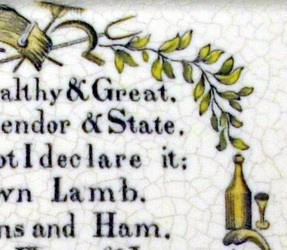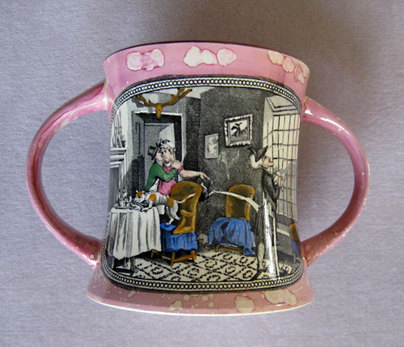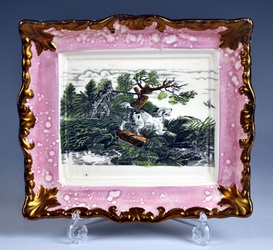|
1/17/2012 0 Comments Yet another post on Adams' reprosOn reflection, it does seem that the group of plaques with distinctive scrolled borders were produced by Adams' Staffordshire pottery (see my previous post). I can't claim credit for this discovery. Ian Sharp told me a year ago he thought the train plaque was a 'fake'. More recently, Steven Moore e-mailed to say the 'Death of Punch' was an Adams' repro. So why has it taken me so long to accept this? Ian's opinion (which I've always valued) was almost in a minority of one. When these plaques appeared in reference books and articles (not just Gibson) they were listed as Victorian. (Although, perhaps tellingly, they do not appear in Baker's 'Sunderland Pottery' – the key work of scholarship on the subject.) Similarly, whenever a Crimean plaque of this kind or a train plaque turned up in an auction house or on a reputable dealer's stall, it was always catalogued as 19th century Sunderland lustre (see lots 384 and 402 in Sotherby's Tolson Collection catalogue, for instance). The vetters of the major antique fairs agreed. The collectors, who were prepared to pay £400 –700 for the train, agreed also. And as discussed at the end of my previous post, the Sunderland Museum accepts the plaques as 'right' and displays them alongside originals. For me the real sticking point was that they looked old – often with cracks, and corners missing. But here are 5 reasons which contribute to why I now believe they are copies (or fakes if you prefer)... 1. They are coloured in too neatlyLook at the idividually painted leaves and farming implements on these plaque details. They are nothing like the slap-dash washes of colour typical of Sunderland potteries like Moore & Scott. N.B. the neat enamel decoration on the right plaque detail above is identical to that on the marked 20th century Adams' cup with the same transfer (see my previous post). 2. They have a 'greasy' feelIan Sharp used the word 'greasy' to describe the feel of these plaques. The glaze has an almost synthetic/plastic quality to it. Ian's description is perfect. But it applies to some plaques more than others, and I've noticed this phenomenon on some Scott plaques too. 3. Some of the colours look wrongThe two details above are from alleged Adams plaques. Some of these colours – the electric blue and scarlet on the right in particular – never appear on plaques from Sunderland. 4. Limited number of a broad range of subjectsIan Holmes noted that according to the way he'd numbered his collection, nearly all of the plaques of this form fell into the 'miscellaneous' category. If they were really made in the 1850s, why no religious verses? Why no ships? The pick and mix choice of subjects seems consistent with someone putting together a range of attractive designs with retro appeal. 5. The transfers don't appear on other lustre itemsWhy does the train transfer never appear on pink-lustre jugs or bowls? Or the Crimean transfer? (N.B. the Dixon version does.) The Death of Punch appears on the reverse side of the pink-lustre loving cup below, but the cup is unlike anything produced in the 19th century. Some final thoughtsWhy do many of the plaques look so old? In my November 24th post I noted that the pottery body of this group of plaques was prone to cracking and stress. Also, the corners of these plaques turn slightly upwards, which makes them particularly vulnerable to damage. I've seen at least four Crimean plaques with damaged or missing corners. And yet it is rare to find one of these plaques (particularly those with pink borders) with rubbed or faded lustre. After believing for so long they were 19th century, I'm loath to put a new date on them. The first half of the 20th century is the best I can suggest. They are old enough to have been worth repairing pre-1950 (see my December 22nd post). They're also old enough to have been accepted as originals by W D John & Warren Baker when they wrote their book 'Old English Lustre Pottery' (1951). Adams added printed marks to much of its 20th century output. The mark on the plaque below was used over a long time frame: at their Greenfield site 1914–1955, and at their Greengates site 1914–1970. The marked plaque doesn't show the same signs of stress or age, so I assume it was made later. Is it possible that some of the unmarked plaques were made in Sunderland, and some in Staffordshire? That doesn't seem likely given that all the unmarked plaques show similar signs of stress, they mostly have the same feel, unusual colouring, and neatly painted enamels. And I've recorded nearly all of them with both pink borders (left below) and copper lustre borders (right below). All of this suggests they came from the same pottery. There are, however, some slight variations to the crispness of the moulding (see below). The Crimean plaque (third below) has the best defined features. The hunting plaque (first below) the least well defined, suggesting it came later from the mould. Will I be putting the Adams-attributed plaques in my collection in a box in the attic? Absolutely not. Unlike the awful 'Flying Cloud Boston' and 'Agamemnon' repros, these items have some intrinsic value, and will continue to be desirable to collectors. What's more, within the next twenty years or so they will be real antiques, if they aren't already! P.S.Ian Holmes points out that the times at which the English and the French got on well enough for a pottery to commission a Crimea plaque are few and far between. He suggests 1904, at the time of the Entente Cordiale, or perhaps 1908 for the Franco-British exhibition. This might fit as a date for the copper-lustre-bordered Crimean plaque, which looks to be the oldest, and is the most common, suggesting a longer span of production.
Ian says that by 1920, items celebrating war had little commercial appeal. Interestingly, around this time, British toy manufacturers switched from making soldiers to farming figures. Perhaps this was a good time for a pottery to produce retro farming verse plaques? But this is an edited selection of Ian's comments. Like me, he's struggling to get his head around this new attribution.
0 Comments
Leave a Reply. |
AuthorStephen Smith lives in London, and is always happy to hear from other collectors. If you have an interesting collection of plaques, and are based in the UK, he will photograph them for you. Free advice given regarding selling and dispersal of a collection, or to those wishing to start one. Just get in touch... Archives
February 2022
AcknowledgementsThis website is indebted to collectors, dealers and enthusiasts who have shared their knowledge or photos. In particular: Ian Holmes, Stephen Duckworth, Dick Henrywood, Norman Lowe, Keith Lovell, Donald H Ryan, Harold Crowder, Jack and Joyce Cockerill, Myrna Schkolne, Elinor Penna, Ian Sharp, Shauna Gregg at the Sunderland Museum, Keith Bell, Martyn Edgell, and Liz Denton.
|











